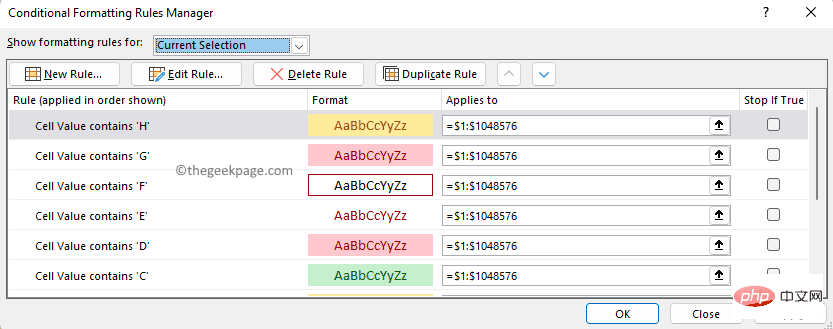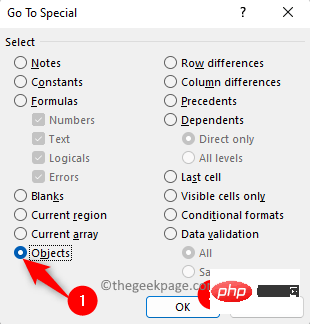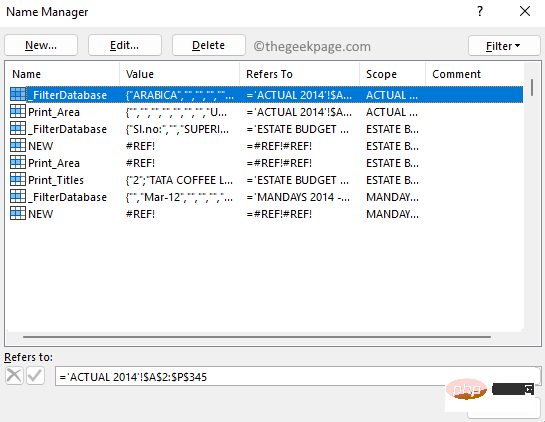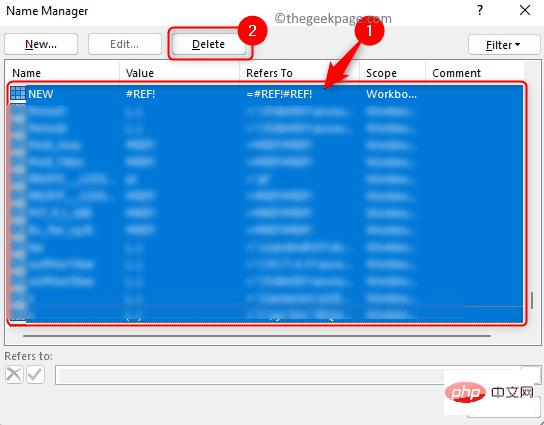
One of the most common file problems faced by users is Excel running slowly. Recently, a large number of users have complained about this problem with Excel spreadsheets. When there is less data in the workbook, the impact on file performance is not noticeable, but as you add more data or calculations to it, you will notice that the Excel workbook starts to run slowly.
Symptoms of a slow Excel spreadsheet
Possible reasons why Excel spreadsheets become slow are as follows
If you're frustrated by slow Excel spreadsheets containing large data sets, you've come to the right place. In this article, we discuss five solutions for each of the above reasons.
When you open an Excel spreadsheet with conditional formatting, you will notice that it takes a long time to open, and operations such as inserting rows also take quite a long time time. The major lag problem occurs when the worksheet has conditional formatting that is not optimized.
To check if your Excel worksheet contains conditional formatting, follow the steps below.
1. Open your Excel worksheet.
Go to the Mainmenu tab.

2. Here, click Find and Select in the Edit group.
In the submenu that opens, select Go To Special.

3. In the Go to Special window, select the Conditional Formatting option.
Click OK.

#It takes a long time to complete the operation and it displays all cells in the worksheet that have conditional formatting.
4. Again, go to the Home tab and click Conditional Formatting in the Styles group.
Select OptionsManage Rules to see if this problem is caused by the set of rules used for formatting.

Now, if Conditional Formatting Rule Manager takes a long time to open, it's a clear indication that conditional formatting is the culprit.

After opening the Conditional Formatting Manager, you will notice that there are a lot of entries. When you have many cells with many different conditional formats, Excel is constantly checking the cells to see if something needs to be changed.
You need to remove these unnecessary conditional formats or structure them in a more efficient way. Below we have mentioned the steps to remove conditional formatting from Excel worksheet.
1. Move the mouse cursor to the upper left corner of the cell to highlight or select the entire worksheet.

2. Go to the Home tab.
In the Styles group, click Conditional Formatting.
Here, go to the Clear Rules menu option and select Clear Rules from Entire Sheet.

At this point, if Excel says it is not responding, you need to wait while it is working and it may take a long time to complete.
When you notice that there is a brief pause before moving in the spreadsheet, or you see shadows of objects on the worksheet, or you Noticed lag when changing cell color or format, it means there are some picture links or objects inserted into the worksheet without your knowledge. When you pasted the cell, you probably selected the Paste linked picture option and therefore the picture link was inserted.
Sometimes you will see regular grid lines as well as some shading of the grid lines. To check if your worksheet is having problems with image links, follow the steps below.
1. Open the Excel worksheet in question.
Click the "Home" tab in the top command ribbon.
2. Find the Edit group in this tab and click the Find and Select button here.
In the menu that opens, select the Go To Special... option.

3. In the Go to Special window, select options by selecting the radio button next to the object.
Then, click OK.

#4. You will see that all object/picture links in the worksheet are highlighted.

Now you just need to press the Delete key on your keyboard since the object is already selected.
After removing these image links, the Excel spreadsheet became faster without any lag.
While working with Excel worksheets, we may hide unused rows and columns so that only the rows or columns with the required information are displayed . In the rest of the space, you'll see a gray background without any cells. However, hiding rows and columns has its own problems. When there are hidden rows/columns, you will notice that there is a pause when entering numbers in the worksheet, but there will be no problem with the formatting of the cells.
In the image below you can see the gray area and it is assumed that there is no information/data in it. However, when you try to change a number in a cell in it, you will see that the Excel worksheet slows down because there are some formulas in other cells that are based on the changed cell value. You'll notice that this process takes a long time to complete because the formulas are always present in all cells, but they are hidden.
Now, right click on the visible last row/column and select the Unhide option to unhide the row/column . Go all the way to the end (the last column of the worksheet) and see if there are any calculations there.

To go to the last column in a row, you can use the Ctrl Shift Arrow key (or the End key) to move your Bring to the end of the visible part.
You can check if these columns/rows are required otherwise select the columns/rows you want to delete and press Delete key to delete calculations from these rows/columns. This will help speed up slow spreadsheets.
So always be aware of these hidden gray areas and do your calculations in them. If these are not done correctly, they can slow down your spreadsheet exponentially.
If you notice that navigating between cells (moving from one cell to the next) becomes slow, or becomes highlighted If moving to the next cell you select is slow after displaying a group of cells, it means there are some named ranges hidden in the Excel worksheet.
1. To view the name range, click the Formulastab and select Name Manager in the Defined Names section.

#This will list some named ranges present in the worksheet.

#2. Create a macro to unhide the name range.
Press Alt F11 to open Visual Basic for Application Editor.
Right click on your workbook and select Insert –> Module.

In the new module, copy and paste the code given below.
子 UnhideHiddenNameRanges()'取消隐藏当前打开的 Excel 文件中的所有名称对于 ActiveWorkbook.Names 中的每个 tempNametempName.Visible = True下一个结束子
Close the VBA editor to return to the Excel worksheet.

3. Select the View tab at the top.
Click the drop-down menu named Macros and select View Macros.

In the Macro window you will see the macro you created. Select this macro and then select the This workbook option in the drop-down list next to Macro in .
Then, click the Run button. This will unhide the named range.

4. Now, go to Formulas -> Name Manager.
You will see that there are name managers for a large number of name ranges in the workbook.
Click the "Range" column to sort them based on their range.
Then, select all name ranges that have Workbook as the scope. Select the first one, hold down the Shift key and go to the last one and highlight it.
Click the Delete button at the top.

#You will be asked to confirm this deletion. Click OK.
After you remove a name range, you'll notice an increase in speed in your Excel spreadsheet while highlighting cells and moving around the worksheet.
Users have noticed that a disconnected or unavailable default printer may be the cause of slowdowns in Excel spreadsheets . When you open an Excel worksheet with an unavailable default printer, the first few interactions are slow and then get better. The reason for the slowdown is that Excel is checking to see if there are any changes to the printer settings. Typically this happens when you move away from the location where you are connected to your default printer.
To resolve this issue, you can change the default printer to a PDF printer or a similar printer available on your computer so that Excel can easily find it.
1. Press Windows R to open the Run dialog box.
Type ms-settings:printers and press Enter to open Printers & Scanners in the Settings app "page.

2. Make sure the switch related to Let Windows manage my default printer is turned off in Printer Preferences .

Microsoft Print to PDF or an existing Any other PDF printer.
 On the Printer page, click the
On the Printer page, click the
button.
 When you open an Excel spreadsheet, you'll find that Excel is faster because it doesn't spend time checking printer settings.
When you open an Excel spreadsheet, you'll find that Excel is faster because it doesn't spend time checking printer settings.
The above is the detailed content of How to Fix Excel Too Slow in Windows 11/10. For more information, please follow other related articles on the PHP Chinese website!
 Cell sum
Cell sum
 Garbled characters starting with ^quxjg$c
Garbled characters starting with ^quxjg$c
 Why the computer keeps restarting automatically
Why the computer keeps restarting automatically
 Usage of SetTimer function
Usage of SetTimer function
 head command usage
head command usage
 How much is Dimensity 6020 equivalent to Snapdragon?
How much is Dimensity 6020 equivalent to Snapdragon?
 How to solve the problem of garbled characters when opening a web page
How to solve the problem of garbled characters when opening a web page
 Cryptocurrency trading platform rankings
Cryptocurrency trading platform rankings




